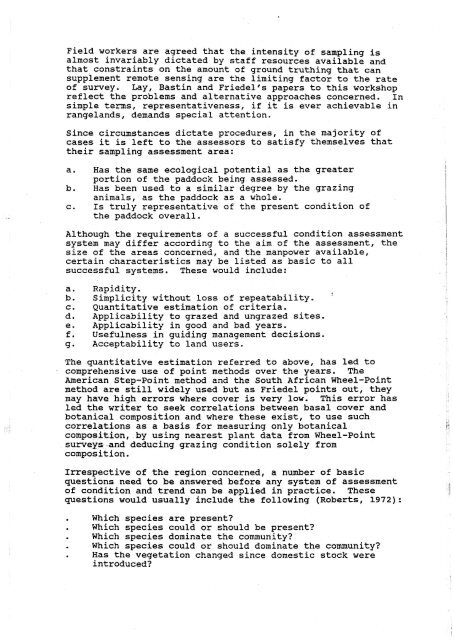soil-conservation-people-religion-and-land.pdf - South West NRM
soil-conservation-people-religion-and-land.pdf - South West NRM
soil-conservation-people-religion-and-land.pdf - South West NRM
You also want an ePaper? Increase the reach of your titles
YUMPU automatically turns print PDFs into web optimized ePapers that Google loves.
~ield workers are agreed that the intensity of sampling is<br />
almost invariably dictated by staff resources available <strong>and</strong><br />
that constraints on the amount of ground truthing that can<br />
supplement remote sensing are the limiting factor to the rate<br />
of survey. Lay, Bastin <strong>and</strong> Friedel's papers to this workshop<br />
reflect the problems <strong>and</strong> alternative approaches concerned. In<br />
simple terms, representativeness, if it is ever achievable in<br />
rangel<strong>and</strong>s, dem<strong>and</strong>s special attention.<br />
Since circumstances dictate procedures, in the majority of<br />
cases it is left to the assessors to satisfy themselves that<br />
their sampling assessment area:<br />
a. Has the same ecological potential as the greater<br />
portion of the paddock being assessed.<br />
b. Has been used to a similar degree by the grazing<br />
animals, as the paddock as a whole.<br />
c. Is truly representative of the present condition of<br />
the paddock overall.<br />
Although the requirements of a successful condition assessment<br />
system may differ according to the aim of the assessment, the<br />
size of the areas concerned, <strong>and</strong> the manpower available,<br />
certain characteristics may be listed as basic to all<br />
successful systems. These would include:<br />
a. Rapidity.<br />
b. Simplicity without loss of repeatability. !<br />
c. Quantitative estimation of criteria.<br />
d. Applicability to grazed <strong>and</strong> ungrazed sites.<br />
e. Applicability in good <strong>and</strong> bad years.<br />
f. Usefulness in guiding management decisions.<br />
g. Acceptability to l<strong>and</strong> users.<br />
The quantitative estimation referred to above, has led to<br />
comprehensive use of point methods over the years. The<br />
American Step-Point method <strong>and</strong> the <strong>South</strong> African Wheel-Point<br />
method are still widely used but as Friedel points out, they<br />
may have high errors where cover is very low. This error has<br />
led the writer to seek correlations between basal cover <strong>and</strong><br />
botanical composition <strong>and</strong> where these exist, to use such<br />
correlations as a basis for measuring only botanical<br />
composition, by using nearest plant data from Wheel-Point<br />
surveys-<strong>and</strong> deducing grazing condition solely from<br />
composition.<br />
Irrespective of the region concerned, a number of basic<br />
questions need to be answered before any system of assessment<br />
of condition <strong>and</strong> trend can be applied in practice. These<br />
questions would usually include the following (Roberts, 1972):<br />
Which species are present?<br />
Which species could or should be present?<br />
. Which species dominate the community?<br />
Which species could or should dominate the community?<br />
. Has the vegetation changed since domestic stock were<br />
introduced?
















